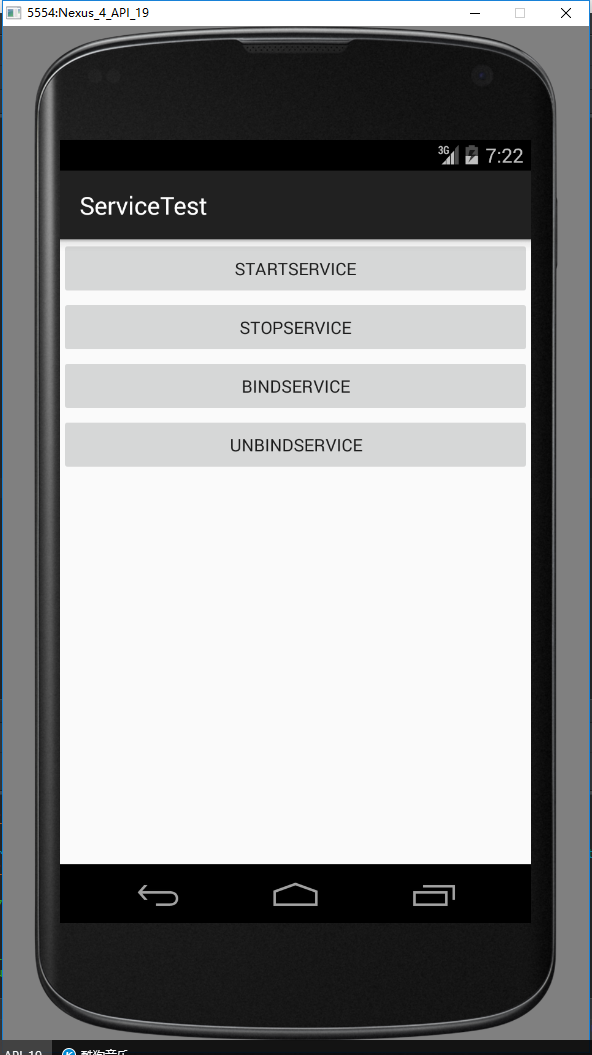Android中 startService()和bindService()的區別
1. startService和bindService關係?
服務不能自己執行。一旦Activity中呼叫了startService()方法啟動Service後,Activity就不能直接控制Service了。這時就需要bindService()把Activity和Service聯絡起來,之後就能在Activity中指揮Service去工作了。
startService()和bindService()都能啟動Service,它們的呼叫順序也會對Service產生影響,具體影響見下文。
2. startService ()時Service的生命週期
通過startService(),Service會經歷 onCreate() –> onStart() 啟動Service。然後stopService()的時候直接onDestroy()。如果呼叫者直接退出而沒有呼叫stopService(),那麼Service會一直在後臺執行。 注意在Service的一個生命週期之內只會呼叫一次onCreate()方法,stopService()之前若多次startService()則只會呼叫onStart()方法。
3. bindService()時Service的生命週期
如果打算採用bindService()方法啟動服務,在服務未被建立時,系統會先呼叫服務的onCreate()方法,接著呼叫onBind()方法。這個時候呼叫者和服務繫結在一起,呼叫者unbindService()退出了,系統就會先呼叫服務的onUnbind()方法,接著呼叫onDestroy()方法。多次呼叫bindService()方法並不會導致多次建立服務及繫結(也就是說onCreate()和onBind()方法並不會被多次呼叫)。
如果bindService()之前Service已經在運行了,那麼這是呼叫unbindService()只會onUnbind()而不會onDestory()。
4. 例項
先做一個TestService類,記得要在AndroidManifest註冊。
public class TestService extends Service {
private static final String TAG="TestService";
private TestBinder mBinder =new TestBinder();
class TestBinder extends Binder{
}
@Override
public int onStartCommand(Intent intent, int 然後主介面設定4個相應的按鈕,佈局檔案相當簡單:
<LinearLayout
android:layout_width="match_parent"
android:layout_height="wrap_content"
android:orientation="vertical"
xmlns:android="http://schemas.android.com/apk/res/android">
<Button
android:id="@+id/btnStart"
android:layout_width="match_parent"
android:layout_height="wrap_content"
android:text="StartService"/>
<Button
android:id="@+id/btnStop"
android:layout_width="match_parent"
android:layout_height="wrap_content"
android:text="StopService"/>
<Button
android:id="@+id/btnBind"
android:layout_width="match_parent"
android:layout_height="wrap_content"
android:text="bindService"/>
<Button
android:id="@+id/btnUnbind"
android:layout_width="match_parent"
android:layout_height="wrap_content"
android:text="unbindService"/>
</LinearLayout>MainActivity:
package example.hp.com.servicetest;
import android.content.ComponentName;
import android.content.Intent;
import android.content.ServiceConnection;
import android.os.IBinder;
import android.support.v7.app.AppCompatActivity;
import android.os.Bundle;
import android.view.Menu;
import android.view.MenuItem;
import android.view.View;
import android.widget.Button;
public class MainActivity extends AppCompatActivity implements View.OnClickListener {
private Button btnStart;
private Button btnStop;
private Button btnBind;
private Button btnUnbind;
private ServiceConnection connection=new ServiceConnection() {
@Override
public void onServiceConnected(ComponentName name, IBinder service) {
}
@Override
public void onServiceDisconnected(ComponentName name) {
}
};
@Override
protected void onCreate(Bundle savedInstanceState) {
super.onCreate(savedInstanceState);
setContentView(R.layout.activity_main);
btnStart=(Button)findViewById(R.id.btnStart);
btnStop=(Button)findViewById(R.id.btnStop);
btnBind=(Button)findViewById(R.id.btnBind);
btnUnbind=(Button)findViewById(R.id.btnUnbind);
btnStart.setOnClickListener(this);
btnStop.setOnClickListener(this);
btnBind.setOnClickListener(this);
btnUnbind.setOnClickListener(this);
}
@Override
public void onClick(View v) {
switch (v.getId()){
case R.id.btnStart:
Intent startIntent=new Intent(this,TestService.class);
startService(startIntent);
break;
case R.id.btnStop:
Intent stopIntent=new Intent(this,TestService.class);
stopService(stopIntent);
break;
case R.id.btnBind:
Intent bindIntent=new Intent(this,TestService.class);
bindService(bindIntent,connection,BIND_AUTO_CREATE);
break;
case R.id.btnUnbind:
unbindService(connection);
break;
default:
break;
}
}
}
4.1 多次startService()+stopService()

可以看到一個生命週期內,onCreate()只會呼叫一次,多次startService()只會呼叫onStartCommand()。
4.2 startService()+bindService()+unbindService()

沒有呼叫onDestory(),說明這時Service還在運作。
4.3 startService()+bindService()+stopService()(+unbindService())
無法呼叫stopService(),必須使用unbindService(),結果如下:

與上面不同的是,這次呼叫了onDestory()。應該可以理解為Service繫結後,必須等繫結者退出後他才能stopService()。
4.4 單獨bindService()+unbindService()

注意到最後unbind的時候呼叫了onDestory()。這個與上面先startService()再bind情況不同。
另外,多次unbind會導致異常。

